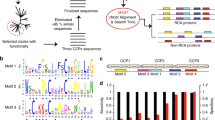Abstract
Complement control protein (CCP) modules, or short consensus repeats (SCR), exist in a wide variety of complement and adhesion proteins, principally the selectins. We have predicted the three-dimensional structure of a CCP module based upon secondary structural information derived by two-dimensional NMR [Barlow et al. (1991), Biochemistry 30, 997–1004]. Accordingly, the CCP is predicted to contain seven β-strands with extensive hydrogen-bonding interactions, and shows a compact, globular structure. Comparison of this model to the X-ray structure of a kringle domain suggests that the CCP unit is more compact than a kringle structure, and that despite their similarities in size and disulfide bond format, the two are not homologous. Although the function of CCP domains is unknown, it is hoped that the structural model presented herein will facilitate further inquiry into how they contribute to so many systems of biological importance.
Similar content being viewed by others
REFERENCES
Barlow, P. N., Baron, M., Norman, D. G., Day, A. J., Willis, A. C., Sim, R. B. and Campbell, I. D. (1991). Secondary structure of a complement control protein module by two-dimensional 1H NMR, Biochemistry 30, 997–1004.
Bevilacqua, M. P., and Nelson, R. M. (1993). Selectins, J. Clin. Invest. 91, 379–387.
Carlacci, L., Chou, K. C., and Maggiora, G. M. (1991). A heuristic approach to predicting the tertiary structure of bovine and somatotropin. Biochemistry 30, 4389–4398.
Chou, K. C. (1992). Energy-optimized structure of antifreeze protein and its binding mechanism, J. Mol. Biol. 223, 509–517.
Chou, K. C. (1995). The convergence-divergence duality in lectin domains of the selectin family and its implications, FEBS Lett. 363, 123–126.
Chou, K. C., and Carlacci, L. (1991a). Energetic approach to the folding of α/β barrels, Proteins Struct. Funct. Genet. 9, 280–295.
Chou, K. C., and Carlacci, L. (1991b). Simulated annealing approach to the study of protein structures, Protein Eng 4, 661–667.
Chou, K. C., Pottle, M., Némethy, G., Ueda, Y., and Scheraga, H. A. (1982). Structure of β-sheets, J. Mol. Biol. 162, 89–112.
Chou, K. C., Némethy, G., Pottle, M., and Scheraga, H. A. (1989). Energy of stabilization of the right-handed βαβ crossover in proteins, J. Mol. Biol. 205, 241–249.
Day, A. J., Campbell, R. D., and Reid, K. B. M. (1989). In Progress in Immunology, Vol. VII, (Melchers, F., et al., eds.), Springer-Verlag, Berlin, pp. 209–212.
Erbe, D. V., Wolitzky, B. A., Presta, L. G., Norton, C. R., Ramos, R. J., Burns, D. K., Rumberger, J. M., Rao, B. N. N., Foxall, C., Brandly, B. K., and Lasky, L. A. (1992). Identification of an E-selectin region critical for carbohydrate recognition and cell adhesion, J. Cell Biol. 119, 215–227.
Furie, B., and Furie, B. C. (1988). The molecular basis of blood coagulation, Cell 53, 505–518.
Gay, D. M. (1983). Subroutines for unconstrained minimization using a model/trust-region approach, Assoc. Comput. Mach. Trans. Math. Software 9, 503–524.
Graves, B. J., Crowther, R. L., Chandran, C., Rumberger, J. M., Li, S., Huang, K. S., Presky, D. H., Familletti, P. C., Wolitzky, B. A., and Burns, D. K. (1994). Insight into E-selectin/ligand interaction from the crystal structure and mutagenesis of the lec/EGF domains, Nature 367, 532–538.
Hollenbaugh, D., Bajorath, J., Stenkamp, R., and Aruffo, A. (1993). Interaction of P-Selectin (CD62) and its cellular ligand: Analysis of critical residues, Biochemistry 32, 2960–2966.
IUPAC-IUB Commission on Biochemical Nomenclature (1970). Abbreviations and symbols for the description of the conformation of polypeptide chains, Biochemistry 9, 3471–3479.
Janatova, J., Reid, K. B. M., and Willis, A. C. (1989). Disulfide bonds are localized within the short consensus repeat units of complement regulatory proteins: C4b-binding protein, Biochemistry 28, 4754–4761.
Mills, A. (1993). Modelling the carbohydrate recognition domain of human E-selectin, FEBS Lett. 319, 5–11.
Momany, F. A., McGuire, R. F., Burgess, A. W., and Scheraga, H. A. (1975). Energy parameters in polypeptides. 7. Geometrical parameters, partial atomic charges, nonbonded interactions, hydrogen bond interactions, and intrinsic torsional potentials for the naturally occurring amino acids. J. Phys. Chem. 79, 2361–2381.
Némethy, G., Pottle, M. S., and Scheraga, H. A. (1983). Energy parameters in polypeptides. 9. Updating of geometrical parameters, nonbonded interactions, and hydrogen bond interactions for the nautrally occurring amino acids. J. Phys. Chem. 87, 1883–1887.
Park, C. H., and Tulinsky, A. (1986). Three-dimensional structure of the kringle sequence: Structure of prothrombin fragment 1, Biochemistry 25, 3977–3982.
Patthy, L. (1985). Evolution of the proteases of blood coagulation and fibrinolysis by assembly from modules, Cell 41, 657–663.
Reid, K. B. M., and Day, A. J. (1989). Structure-function relationship of the complement components, Immunol. Today 10, 177–180.
Sim, R. B., and Perkins, S. J. (1989). Molecular modelling of C3 and its ligands, Curr. Top. Microbiol. Immunol. 153, 209–222.
Weis, W. I., Kahn, R., Fourme, R., Drickamer, K., and Hendrickson, W. A. (1991). Structure of the calcium-dependent lectin domain from a rat manose-binding protein determined by MAD phasing, Science 254, 1608–1615.
Wharton, K. A., Johansen, K. M., Xu, T., and Artavansis-Tsakpnas, S. (1995). Nucleotide sequence from the neurogenic locus notch implies a gene product that shares homology with proteins containing EGF-like repeats, Cell 43, 567–581.
Williams, A. F., and Barclay, A. N. (1988). The immunoglobulin superfamily—Domains for cell surface recognition, Annu. Rev. Immunol. 6, 381–405.
Author information
Authors and Affiliations
Rights and permissions
About this article
Cite this article
Chou, KC., Heinrikson, R.L. Prediction of the Tertiary Structure of the Complement Control Protein Module. J Protein Chem 16, 765–773 (1997). https://doi.org/10.1023/A:1026363816730
Published:
Issue Date:
DOI: https://doi.org/10.1023/A:1026363816730




